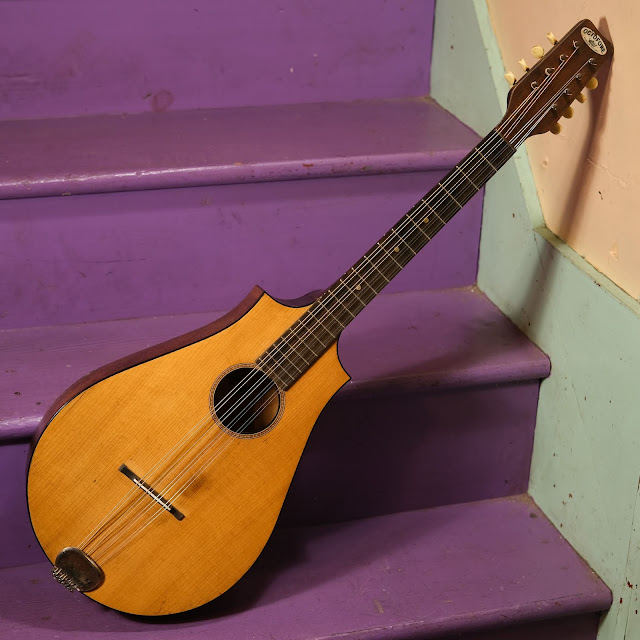1930s Regal Octofone Octave Mandolin
I've written a lot about Octofones in the past. Regal marketed these as "8 instruments in one" depending on how you string and tune them. At the time it was built, tenor banjos, ukuleles, and mandolins were very popular and so there were plenty of players looking for an instrument to "double on." This one is the "mid-grade" model Octofone and is spruce-over-birch. There were all-birch instruments as well as spruce-over-mahogany ones, too.
They fit the mold of a modern "octave mandolin," however, and so that's how most people play them these days. They're more-or-less mandolin-shaped, have a tenor-guitar-like (or octave-mandolin-like) 21" scale length, and doubled courses.
The problem with thinking of them as a modern octave mandolin, though, is that people usually over-string them and they arrive with a typical set of structural issues. I've only met a couple latter-era Octofones (late '30s models) that were built more-heavily and had thicker maple necks. Those ones can handle the modern-age, heavier, octave mandolin string gauges. This earlier style (the most-prevalent), simply cannot.
This arrived via customer repair a long time ago and I finally found a place for it in the queue. All of its back braces were loose and it had some funky fill-jobs to a couple of back cracks. The neck had been "reset" with some sploshed-in glue and a bolt on the inside (hey, it worked for the most-part -- and these have a doweled joint so they actually need a lower bolt to stay stable). The worst of it was that the neck was fairly warped (typical) and the top braces were almost all unglued or split.
After righting these wrongs and stringing it very light, it now sounds great and feels about like playing a tenor banjo setup-wise. One has to use a thinner pick and not hammer on it like you would on a modern octave mandolin, but you're rewarded for changing your style with a rich, warm, full, expansive sound that you just don't get from a typical, heavily-strung instrument. It also plays fast-fast-fast.
Repairs included: neck re-reset, fret level/dress, side dots install, brace repairs to the back, three new (wider/flatter, cedar) braces for the top, a new compensated bone saddle for the bridge, cleaning, and setup.
Made by: Regal
Model: standard Octofone
Made in: Chicago, IL, USA
Top wood: solid spruce
Back & sides wood: solid birch
Bracing type: ladder
Bridge: ebonized birch, bone saddle
Fretboard: ebonized maple
Neck wood: poplar
Tone: sweet, warm, full, rich
Action height at 12th fret: 1/16" overall (spot-on)
String gauges: 38w, 24w, 14, 10 low to high
Neck shape: medium-C
Board radius: flat
Truss rod: none
Neck relief: minor relief (leveled out via frets)
Fret style: smallish
Scale length: 21"
Nut width: 1 3/8"
String spacing at nut: 1 1/8"
String spacing at bridge: 1 11/16"
Body length: 15 3/4"
Body width: 10 5/8"
Body depth: 3"
Weight: 2 lb 0 oz
Condition notes: a couple of not-so-hot fill jobs to old hairline cracks on the back, average usewear and scratching throughout. The top and sides are crack-free, though. Three top braces are replacements: the one under the fretboard extension is now much wider and more of a "block" for increased support. The two below the soundhole are slightly wider and flatter and I moved both about 1/2" closer to the bridge. This helps with another typical problem on these -- belly sag at the bridge. The sag tends to distort the top over time quite a bit. It's not entirely gone, now, but it's a whole lot better.
















Comments